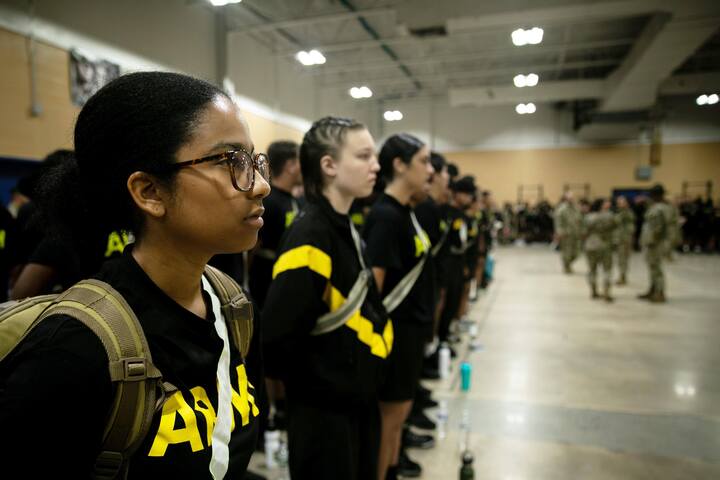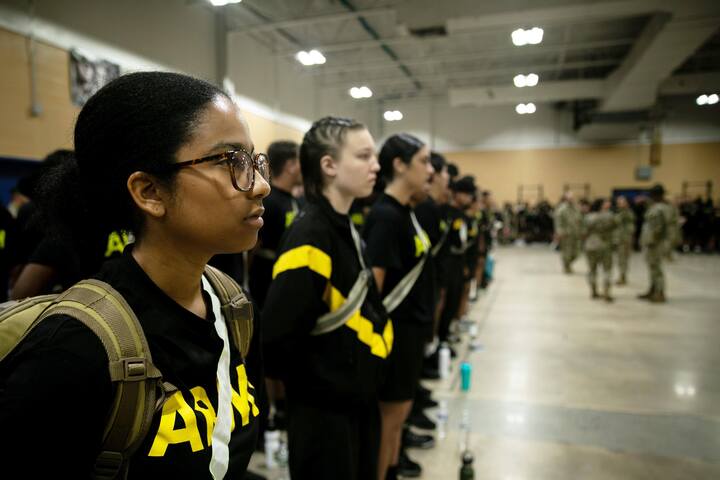

The Army is back to meeting its recruiting goals, but with recruits that are skewing older than they used to and who often need academic or fitness help before boot camp, officials said Thursday.
With a new focus on those two groups, the Army exceeded its fiscal year 2024 recruiting goal for enlisted soldiers with just over 55,300 recruits, a rebound after two years of misses.
Maj. Gen. Johnny Davis, commander of Army Recruiting Command, told reporters that the Army’s average recruit is now 22 years, 4 months old and still “going up.” He also said it’s in line with Secretary Christine Wormuth’s goal announced in October to have one-third of the entire force be made up of college graduates.
“That enlistment age only tells us, hey, there’s another market that we’re not really fully in,” Davis said. “We’re in the high school market – that is growing. But we really want this labor market to really grow for those who are older.”
The Army’s maximum enlistment age is 38 but the service’s push for older recruits has led to some cases of soldiers enlisting much later in life. Michael Powell was rejected at 19 years old for not meeting enlistment standards but received waivers for his age and tattoos at 39. Another unique case is 41-year-old Jason Pelletier who was discharged from the Air Force two decades ago for discipline issues and joined the Army Reserve this year.
Davis said a primary challenge with courting older recruits is offering the right incentives. High schoolers, he said, have GI Bill benefits to look forward to and college grads are attracted to the service’s loan repayment programs. But with the older recruits already in the labor market, officials are still working through other incentive ideas.
In addition to recruiting older soldiers, the Army has also invested in recruiting those who do not meet the military’s academic or physical fitness standards but have an interest in joining.
About 13,200 trainees — roughly one of every four recruits — went through a new Army Future Soldier Prep Course.
The program gives potential soldiers who do not meet fitness or academic standards 90 days of additional training before heading off to bootcamp. Since its inception in August 2022, over 90% of the program participants have graduated from the course, leading to more than 28,000 recruits joining the active duty Army, National Guard and Reserve, Brig. Gen. Jenn Walkawicz, deputy chief of staff in charge of operations, planning and training for Army Training and Doctrine Command, told reporters.
Separately, the Army has placed 11,000 potential recruits in the Delayed Entry Program for fiscal year 2025. Under this program, recruits can sign enlistment contracts but still finish civilian considerations like school before shipping out to basic training later.
New ways of recruiting
The Army’s recruitment upswing comes after Wormuth’s announcement in October to overhaul and modernize the way the service recruits – realizing that the service needed to invest in more online outreach to attract Gen Z and compete with the private sector. In addition to looking beyond high school, recruiters are trying to meet potential soldiers where they’re at by using a recruit mobile app and digital job boards, Davis said.
The Army also created two new military occupational specialties: 420T Talent Acquisition Technicians and 42T Talent Acquisition Specialists modeled off of corporate recruiters in the private sector.
In 2022 and 2023, , the service brought in just 45,000 recruits annually, 15,000 less than its annual goal. This year, the Army met lowered its goal to 55,000, Kate Kuzminski, director of the military, veterans, and society program at a the Center for New American Security, a Washington D.C. think tank, said the lowered number and new approach is part of the service’s plans to realign its force to be ready for potential future conflict with Russia or China.
“The reduction in end strength is tied to a change in force structure that is moving from the brigade combat team structure back to a core and division-led structure because that is what we’ll need for near peer competition and or near peer conflict,” Kuzminski said.
Subscribe to Task & Purpose today. Get the latest military news and culture in your inbox daily.
With the new structure, the Army needs to maintain its recruiting of infantry soldiers, who make up 22% of its annual contracts, but also get recruits interested in “high-need” specialties like air defense. By incentivizing those critical positions to recruits, recruiters were able to get 6,000 new soldiers to fill those spots this past year, officials said.
The Army is also assessing how it handles health conditions that have been disqualifying for potential recruits like those related to mental health, orthopedic, cardiac and vision issues like, Davis said. Despite the challenges with MHS Genesis, he said the program gives insight into the type of waivers they see most often, what types of health conditions are caught up in the pipeline and how to move them through the process faster.
“Let’s say astigmatism (which causes blurry vision), if we’re approving those waivers – now that we know more, 98% of the time, why are we going through the waiver process?,” Davis said. “As a waiver authority, me and my other service commanders, why don’t we just pull that to our level and really prevent an applicant from waiting 30 days?”
As part of the recruitment overhaul, the service also created a “recruit innovation cell” to brainstorm unique ways to meet and attract potential recruits. One of the initiatives that the Army has been testing for two months in five cities across the U.S. called “Recruit 360” is a partnership with Deloitte, a corporate consulting firm, to use artificial intelligence to look at wider applicant pools.
The Army hopes AI will help recruiters focus on certain traits – like those that are athletes or like sports – which might indicate their interest in the military or unearth methods for recruiters to connect with them on a more personal level, Davis said.
“They will help us with that in terms of looking at that applicant pool so when our recruiters talk to them, they can talk to them given that background information instead of what we’ve been doing in the past is really taking a high school list and cold calling 2-or-300 high school seniors,” he said. “That is what we have to get away from.”
